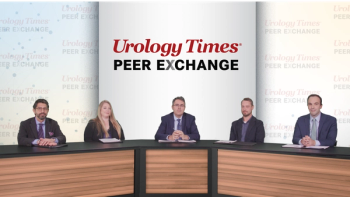
Opinion|Videos|May 23, 2025
Case 1: A 79-Year-Old Man With Non–Muscle-Invasive Bladder Cancer
Panelists discuss how they approach a typical bladder cancer case of a 79-year-old man with hematuria, including initial diagnostic procedures, the importance of proper tumor measurement during resection, BCG therapy protocols, and management options for BCG-unresponsive disease with a focus on nadofaragene firadenovec (Adstiladrin).
Advertisement
Video content above is prompted by the following: Case Presentation and Management of BCG Unresponsive Disease
Key Discussion Themes:
- Patient Profile Analysis: The panel reviewed a case of a 79-year-old African American man with fatigue and hematuria, discussing typical presentation patterns of bladder cancer patients.
- Diagnostic Approach: Experts shared their perspectives on initial workup, emphasizing the importance of office cystoscopy before taking patients to the operating room for transurethral resection.
- Tumor Measurement Techniques: The panel discussed various approaches to measuring bladder tumors, including using the loop size as reference and considering specimen weight.
- Treatment Options Post-BCG Failure: Detailed discussion of treatment strategies for BCG unresponsive disease, including radical cystectomy and bladder-sparing alternatives like nadofaragene firadenovec.
Notable Insights:
- Dr Murray advocated for performing initial cystoscopy in the office rather than going directly to the operating room, noting this helps patients understand what surveillance will involve and empowers them in their care journey.
- Dr Schmidt highlighted recent data suggesting that patient-reported quality of life outcomes may improve after radical cystectomy compared to lines of bladder-sparing therapies.
- Dr Kamat stressed that transurethral resection (TURBT) is “the most critical first step in the management of bladder cancer patients,” noting concerning data showing residual disease rates of 58% to 60% across the US.
- Dr Murray shared her approach to patient education using parallel timelines: one for cystoscopy/CT scan surveillance and another for BCG treatment, emphasizing strict adherence to 3-month cystoscopy surveillance for high-risk patients.
- The panel discussed nadofaragene firadenovec’s efficacy data from the CS-003 trial, noting a 53% complete response rate at 3 months in patients with carcinoma in situ, with Dr Schmidt highlighting the advantage of quarterly administration.
- Dr Chang mentioned a recent study showing that pretreatment with intrarectal valium dramatically reduced bladder spasms and medication loss from 30% to 4%, an important consideration for highly pretreated bladder cancer patients.
Newsletter
Stay current with the latest urology news and practice-changing insights — sign up now for the essential updates every urologist needs.
Advertisement
Latest CME
Advertisement
Advertisement
Trending on Urology Times
1
Sildenafil cream for female sexual arousal disorder available to prescribe in select states
2
Experts urge FDA to revisit labeling for testosterone replacement therapy in men
3
FDA approves ProVee System for benign prostatic hyperplasia
4
Mohit Khera, MD, recaps key takeaways from FDA panel on TRT for men
5


















